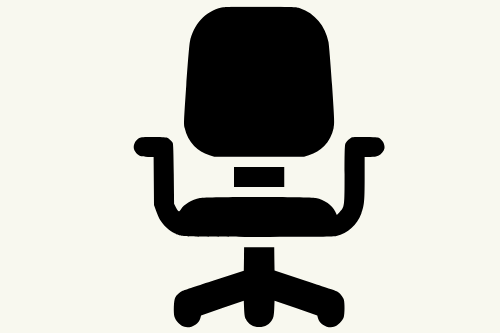The Knob under Your Office Chair
If you’ve ever wondered about the purpose of that mysterious knob under office chair, you’re not alone. That small, often overlooked lever or knob can make a significant difference in your seating comfort and ergonomics.
In this article, we’ll explore the essential things you need to know about the knob under your office chair and how it can improve your overall sitting experience.
When it comes to office chairs, proper ergonomics, and adjustability are key factors in ensuring comfort and reducing the risk of musculoskeletal issues. The knob under your office chair plays a vital role in achieving the right posture, lumbar support, and overall comfort. Let’s dive into the essential details.

Understanding the Knob’s Function
The knob under your office chair is typically a height adjustment mechanism. It allows you to modify the chair’s height according to your preference and the requirements of your workstation.
By raising or lowering the chair, you can align your body correctly, promoting better posture and reducing strain on your back, neck, and shoulders.
Different Types of Height Adjustment
Office chairs feature various types of height adjustment mechanisms, depending on the make and model. The most common type is a pneumatic lever that controls the chair’s gas lift cylinder.
By pulling up on the lever, you can raise the chair’s height, while pushing it down lowers the height.
Some chairs may have a manual height adjustment mechanism, where you rotate a knob or turn a bolt to raise or lower the chair. Mechanical height adjustments, such as ratchet systems, are also available in certain chairs.
Achieving the Right Chair Height
To find the optimal chair height, follow these steps:
- Start by sitting on the chair with your feet flat on the floor or using a footrest if needed.
- Adjust the knob or lever under the chair to raise or lower it until your knees are at a 90-degree angle and your thighs are parallel to the floor.
- Ensure that your feet are comfortably resting on the floor or footrest and that your hips are slightly higher than your knees.
- Sit up straight with your back against the chair’s backrest, maintaining a natural curve in your spine.

Additional Adjustments for Comfort
While the knob under your office chair primarily controls the chair’s height, many chairs offer additional adjustments for optimal comfort. These may include:
- Tilt adjustment: Some chairs allow you to adjust the tilt tension, enabling you to recline or lock the chair in a fixed position.
- Lumbar support: Certain chairs provide a knob or lever specifically for adjusting the lumbar support. This helps maintain the natural curve of your lower back.
- Armrest adjustment: If your chair has adjustable armrests, use the corresponding knobs or levers to position them at a comfortable height and distance from your body.
The Tilt Tension Feature on Office Chairs: Enhancing Your Reclining Experience
When it comes to office chairs, comfort and adjustability are crucial for a productive work environment. One important feature that contributes to your sitting experience is the tilt tension adjustment. This feature allows you to modify the resistance of the chair when reclining, offering personalized support and comfort. In this article, we will delve into the tilt tension feature on office chairs and explore how it enhances your reclining experience.
Sitting in the same position for extended periods can cause discomfort and strain on your body. The tilt tension feature on office chairs provides you with the ability to adjust the resistance and ease of reclining. This allows you to find the perfect balance between relaxation and support while sitting for long hours. Let’s explore this feature in more detail.
Understanding Tilt Tension
The tilt tension feature controls the resistance or tension of the chair’s backrest when reclining. By adjusting this setting, you can determine how easily or firmly the chair reclines when you lean back. It provides a customizable reclining experience tailored to your preference and body weight.
Adjusting the Tilt Tension
To adjust the tilt tension on your office chair, follow these steps:
- Locate the tilt tension knob or lever, typically located beneath the seat or on the side of the chair.
- If the chair has a knob, turn it clockwise to increase the tension and make reclining more difficult. Turn it counterclockwise to decrease the tension and make reclining easier.
- If the chair has a lever, move it forward or backward to increase or decrease the tension respectively.
Experiment with different settings to find the level of resistance that feels most comfortable and supportive to you. It’s important to strike a balance between ease of reclining and maintaining adequate back support.
Benefits of Tilt Tension Adjustment
The tilt tension feature offers several benefits:
- Personalized comfort: By adjusting the tilt tension, you can find the ideal reclining resistance that suits your body and preferences. This ensures a comfortable seating position that minimizes strain and fatigue.
- Enhanced support: The tilt tension feature allows you to maintain proper posture while reclining. It ensures that the chair provides adequate back support and prevents you from slouching or straining your back.
- Dynamic movement: With the right tilt tension setting, you can enjoy gentle movement and promote blood circulation while sitting. This can help reduce stiffness and improve focus and productivity.
Factors to Consider
When adjusting the tilt tension, consider the following factors:
- Body weight: Heavier individuals may require higher tension to achieve optimal support, while lighter individuals may prefer lower tension for easier reclining.
- Task requirements: Consider the nature of your work. Jobs that involve more focus and precision may benefit from a slightly firmer tilt tension to minimize excessive movement.
- Personal preference: Experiment with different tilt tension settings to find what feels most comfortable and supportive to you. Adjust it according to your individual needs and preferences.
Regularly Reassess and Readjust
Remember that your seating needs may change over time. It’s crucial to reassess and readjust your chair periodically to maintain optimal comfort and support. Experiment with different settings to find the configuration that works best for you.
Conclusion
The knob under your office chair is more than just a minor feature – it’s a key component in achieving proper ergonomics and comfort. By understanding its function and using it to adjust your chair’s height, you can create an optimal seating environment that promotes good posture and reduces discomfort during long hours of work.
FAQs
- Q: Are all office chairs equipped with a height adjustment knob?
- A: Not all office chairs have the same adjustment mechanisms. While most chairs offer height adjustment, the specific design and type of adjustment may vary.
- Q: How do I know if my chair is properly adjusted for my body?
- A: A properly adjusted chair should allow you to sit with your feet flat on the floor, knees at a 90-degree angle, and thighs parallel to the floor. Additionally, your back should be supported, and your arms should rest comfortably on the desk or armrests.
- Q: Can the knob under the chair be used to adjust the chair’s tilt?
- A: The knob under the chair is primarily for height adjustment. However, some chairs may have separate controls for adjusting the tilt tension or angle.
- Q: What should I do if the knob under my chair is not functioning correctly?
- A: If you’re experiencing issues with the knob or lever, it’s best to consult the chair’s user manual or contact the manufacturer for guidance on troubleshooting or repairs.
- Q: Are there any other adjustments I should consider for a comfortable office chair setup?
- A: In addition to height adjustment, consider adjusting the tilt tension, lumbar support, and armrests, if available, to further enhance your comfort and support while sitting.








